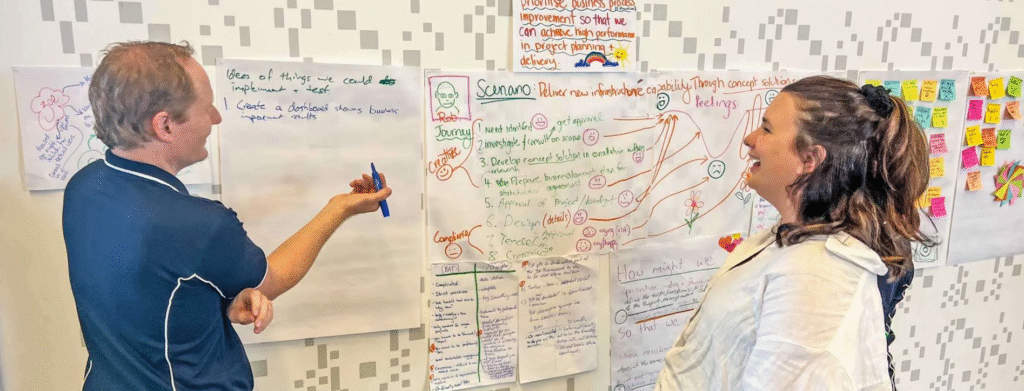In today’s fast-paced and ever-evolving business landscape, creative problem-solving is no longer a luxury—it’s a necessity. One of the most effective ways organizations can foster innovation is by attending a Design Thinking Workshop. These workshops offer a practical, hands-on approach to addressing complex challenges by putting human needs at the heart of the problem-solving process.
What is Design Thinking?
Design Thinking is a mindset and methodology that encourages creative solutions through empathy, collaboration, ideation, and rapid prototyping. It was originally developed in the design world but has since been adopted across various industries such as education, healthcare, government, and corporate sectors.
Unlike traditional problem-solving approaches, Design Thinking is non-linear and iterative. It encourages participants to deeply understand the people they’re designing for before jumping to solutions. This results in outcomes that are both innovative and user-centered.
Why Attend a Design Thinking Workshop?
A Design Thinking Workshop is more than just a brainstorming session. It’s a structured experience that guides participants through the stages of the Design Thinking process: empathize, define, ideate, prototype, and test. These workshops offer several benefits:
1. Boost Creativity and Innovation
Workshops are designed to help teams think outside the box. By removing the fear of failure and promoting an open-minded environment, participants are more likely to explore bold, unconventional ideas.
2. Solve Real-World Problems
Design Thinking Workshops aren’t theoretical. They focus on actual challenges faced by organizations. This makes the experience highly practical and immediately applicable to the workplace.
3. Build Collaboration Across Teams
One of the strengths of Design Thinking is its ability to break down silos within organizations. Workshops bring together individuals from different departments, fostering teamwork and cross-functional communication.
4. Improve Customer Experience
At the core of Design Thinking is empathy. By understanding the needs, desires, and frustrations of end-users, businesses can create products, services, and experiences that truly resonate with their customers.
5. Accelerate Decision-Making
Rapid prototyping and iterative testing allow teams to quickly assess what works and what doesn’t. This cuts down the time spent debating ideas and speeds up the path to effective solutions.
What Happens During a Design Thinking Workshop?
Although every workshop can be tailored to specific goals or industries, the overall structure tends to follow a similar pattern:
Empathize
Participants begin by exploring the user’s world. This could involve user interviews, observations, or storytelling exercises. The goal is to gain deep insights into users’ needs and behaviors.
Define
Next, teams narrow down the focus by crafting clear and actionable problem statements. This ensures everyone is solving the right problem.
Ideate
This is where creativity comes alive. Teams brainstorm a wide range of ideas, encouraged by prompts and structured techniques to push beyond their initial thoughts.
Prototype
Ideas are turned into tangible prototypes—anything from sketches and role plays to physical models. The goal is to bring ideas to life quickly and inexpensively.
Test
Participants get feedback by testing their prototypes with real users or simulated environments. This helps refine ideas and improve solutions before implementing them on a larger scale.
Who Should Attend?
Design Thinking Workshops are ideal for professionals from all backgrounds and industries. Whether you’re a startup founder, team leader, HR manager, or part of an innovation team, the workshop provides valuable tools to tackle any kind of challenge creatively and collaboratively.
You don’t need to be a designer to benefit. In fact, people with no prior experience in creative problem-solving often find these workshops particularly eye-opening and empowering.
Virtual or In-Person: What’s Right for You?
With the changing nature of work, Design Thinking Workshops are now available both in-person and online. Virtual workshops offer flexibility and convenience, while in-person sessions provide richer, more immersive interactions. The best workshops offer both options and can tailor the format to meet the specific needs of a business or team.
Lasting Impact of Design Thinking Workshops
Beyond the immediate benefits, these workshops create a ripple effect throughout an organization. Teams not only walk away with a solution to a pressing challenge but also develop a new way of thinking that they can apply long after the workshop ends.
Design Thinking empowers individuals and organizations to navigate complexity with confidence, creativity, and empathy. It equips participants with a repeatable process that encourages continuous learning and innovation.
Conclusion
Design Thinking Workshops offer a dynamic and effective way to spark innovation, enhance collaboration, and generate user-centered solutions to real-world problems. By immersing participants in a hands-on experience, these workshops create a lasting impact that transforms how people approach challenges. If you’re looking to shift your team’s mindset, improve customer experiences, and build a culture of creativity, consider exploring the transformative power of a Design Thinking Workshop with Simon Banks.







